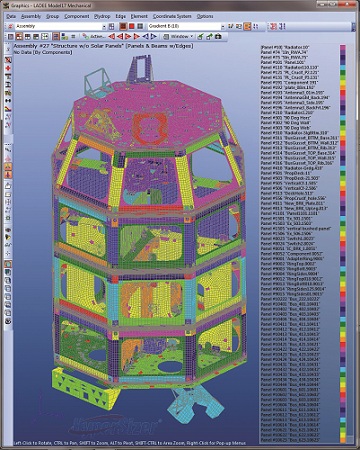Posted on 7/1/2012
Source: Manufacturing Engineering Media
For many industries, composites are the material of choice for achieving lightweight, fuel-efficient and strong designs. The challenge going forward for engineers is to take full advantage of the properties of composites by using advanced analysis tools to predict margins of safety, performance, cost, and design for manufacturability (DFM) without adding unneeded weight at each juncture of the engineering design creation and review process.
HyperSizer v6.2 software from Collier Research Corp. (Newport News, VA) is used widely in the spacecraft and aviation industries and includes new modeling capabilities for airframe wing box designs as well as laminate zone and ply-count optimization enhancements to improve manufacturing efficiency. HyperSizer’s capabilities are also appropriate for applications in wind turbine blades, ship hull and superstructures, high-speed railcars, and automobile body components, helping teams move from conceptual design studies through to final validation for aerospace, wind, shipbuilding, railroad and automotive composite applications.
“Composites are booming due to stepped-up fuel consumption efficiency goals,” says Craig Collier, president of Collier Research. “This is pushing the movement towards light-weighting. But creation of lighter, stronger designs is limited by many of today’s standard industry practices. Weight is needlessly added because engineers have only a partial view of options. They often overdesign to play it safe.”
“It’s a robust analysis tool that allows
us to complete our weight and strength studies in far less time, while finding
optimal ply coverages.”
To overcome such drawbacks, HyperSizer targets weight while serving as an independent and neutral data exchange hub for CAD, FEA, and composite software packages. It iterates with FEA solvers, calculates margins of safety, validates failure predictions with test data, and sequences composite laminates for fabrication—avoiding weight growth as designs mature.
“HyperSizer works from preliminary design through flight certification,” says Collier. “This gives the engineering team a more wide-open conceptual design space for performing trade studies involving thousands of alternatives. They can find robust solutions that lead to significant weight and cost savings. On average our customers reduce weight by 20%.”
“In the past, our designs were often overweight,” says Ian Fernandez, former materials and analysis lead on NASA Ames Research Center’s LADEE satellite project. “HyperSizer has enabled our Center to be more competitive in this regard. It’s a robust analysis tool that allows us to complete our weight and strength studies in far less time, while finding optimal ply coverages.”
HyperSizer has been used on a wide variety of NASA spacecraft projects including the current Space Launch System (SLS) rocket, previous Ares I and V launch vehicles, the Composite Crew Module, and the metal Orion Multi-Purpose Crew Vehicle. Commercial aviation customers include Boeing, Bombardier, Goodrich, Gulfstream, and Lockheed Martin.
New features and enhancements in HyperSizer v6.2 include:
Discrete Stiffener Modeling—For airframe wing box and fuselage structures, the software automatically identifies in the FEM, skin shell and stiffener beam elements and optimizes their spacings, heights, and laminates.
Laminate Optimization for Manufacturability—An improved, six-step process optimizes laminates (transition zones, ply-count compatibility, ply drops/adds, global ply tracking) while balancing strength, stability, and manufacturability. This leads to fabrication efficiencies and factory-floor cost-savings.
